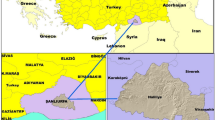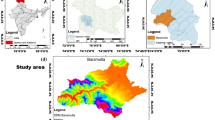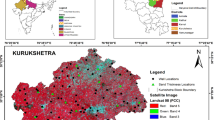Abstract
Groundwater potential zones perform a crucial function in hard rock terrain. With this view, the study has been carried out to identify the groundwater prolific zones using remote sensing (RS) and geographical information system (GIS) in Kamina sub-watershed of Bhima River Basin, Shirur Taluka of Pune District, Maharashtra, India. The thematic maps such as geology, geomorphology, DEM, slope (%), rainfall, soil, drainage density, dug well density, borewell density, land use/land cover mapswere generated to identify the potential zones. Saaty’s Analytical Hierarchy Process (AHP) is an efficient tool for the delineation of groundwater potential zones. The AHP proposes a weight for each evaluation criteria according to the decision maker’s pairwise comparisons of the criteria. The hierarchy is built depending on the degree of influence made by each factor on groundwater potentiality. Finally, the AHP combines the criteria weight and the option scores. The ground water potential zone map so generated is divided into four classes (very low, low, moderate and high) depending on the possibility of groundwater potential. The resultant map depicts that 15.91, 23.3, 23.96, and 36.83% of the area represents ‘‘poor,’’ ‘‘moderate,’’ ‘‘high,’’ and ‘‘very high’’ groundwater favorable zones, respectively. The highest potential area is located toward eastern and southern region because of flood plains facilitating high infiltration, drainage of Ghodriver and thick soil cover. The areas having low potential is toward the basin boundary and northern parts of the study area due to highly dissected plateau, poor soil depth, steep slopes and low infiltration rate. The findings of the studycan helpin the formulation of an efficient management plan for sustainable development of the area.
Access provided by Autonomous University of Puebla. Download chapter PDF
Similar content being viewed by others
Keywords
9.1 Introduction
In most parts of the world, groundwater acts as a prime source for drinking and domestic supply, hence the source strengthening becomes utmost important. Besides, the search for new sources has become essential due to the increasing demand for water. Currently, about 34% of the total annual drinking water supply is fulfilled by groundwater resources. Thus, an identification of potential areas is extremely significant, in future to have a non-contaminated source of drinking water and groundwater would also play a key role in sustainable water resource management. In India, especially in rural regions, groundwater is largely drawn from dug wells, mainly for agricultural and domestic purposes wherein about 65% area represents hard rock aquifers with poor primary porosity (<5%) and very low permeability (10–1–10–5 m/day) (Saraf and Choudhary, 1998). Hence a very detail and extensive hydrogeological investigationsare required for thorough understanding of the groundwater status.
The RS and GIS tools have opened new paths in water resources studies. RS-GIS techniques are widely used for the management of various natural resources (Maggirwar and Umrikar 2009; Magesh et al. 2011; Magesh and Chandrasekar 2014; Yadav et al. 2014; Samal et al. 2015). RS techniques help providing multispectral, high resolution and multi-sensor data with high periodicity (Choudhary et al. 2003). In past few decades, application of integrated remotely sensed data with conventional maps and field data, has made it easy to decipher the groundwater potential zones. Exploration and delineation of groundwater potential zones using RS-GIS techniques are performed by various researchers and the derived results are found to be reliableby verifying with field surveys (Jankowski 1995; Krishnamurthy et al. 1996; Murthy 2000; Shahid et al. 2000; Sener et al. 2005; Solomon and Quiel 2006; Nagarajan and Singh 2009; Dar et al. 2010; Maggirwar and Umrikar 2011; Dutta and Karmakar 2016). In this study a special focus is given to the identification of groundwater potential zones in Kaminasub-watershed, Shirur district, Pune using the advanced remote sensing and GIS tools for the development, policy making and effective administration of groundwater resources.
9.2 Study Area
Kamina sub-watershed lies between 18–19 ° 02″N latitude and 74–74 ° 57″ E longitudes, covering an area of 150.80 sq. km and has been included in Survey of India.
Topographic Sheet Numbers 47J/1, 47J/2, 47J/5, 47J/6, 47J/10 and 47J/11 on the numerical scale of 1: 50,000 (Fig. 9.1). The sub-watershed includes the part of Pabal and Shirur circle along with 14 villages. The maximum length of the sub-watershed is 25 km and maximum width of about 12 km. The area prominently shows basaltic lithology comprising different lava flow units. The area is divided into two major physical divisions namely plateau region and flood plain region. It has the elevation range of 600–720 m which represents a middle level plateau. The study area experiences a hot, dry and tropical monsoon climate. The average annual rainfall in this area ranges between 600 and 700 mm.
9.3 Materials and Methods
This research is basically based on the secondary data. Topographical maps, geological map (Geological Survey of India), and Soil map (National Bureau of Soil Survey Maharashtra state) was used to prepare various thematic maps. SRTM data have been used for generating the Digital Elevation Model and slope map with the help of ArcGIS Spatial Analyst module. Density tool in GIS environment is used to prepare the drainage density, dug well density and tubewell density maps. Landsat ETM (path 147, row 47) image of 30 m resolution dated February 24th, 2015 downloaded from Bhuvan. Supervised classification method and maximum likelihood Algorithm were employed to detect the land use land cover. Thomas Satty’s Analytical Hierarchy Process (AHP) method was used to allocation of weights to each parameter.
9.4 Results and Discussion
9.4.1 Geology and Morphometric Characteristics
The types of geological features were found to be simple basaltic lava flow. The exposures of vesicular/amygdaloidal basalts as well as fractured/jointed basalts are observed during the field work. This sub-watershed area consists of various lava flow units of Indrayani, Upper Ratangirh and Karla Formation with different thickness.
The drainage density is high in the middle and lower parts of the basin showing dendritic drainage pattern (Figs. 9.2 and 9.3). Drainage system is one of the important components of the physical environment. Kamina is the tributary of Bhima river. It originates at Gholapwadi of Kanhur Mesai village at 720 m elevation above mean sea level. Kamina is a fifth order river and the length of longest stream is 30.10 km. The total length of first order streams is 171.77 km and the fifth order stream is 9.07 km. The minimum and maximum bifurcation ratio values are 2 and 4.29.Stream frequency of Kamina sub-watershed is 2.26775.
Drainage density, according to Horton (1932), is defined as the length of streams per unit area. The drainage density value is 2.005 which indicates the study area is underlain by impermeable lithology with moderate relief. The drainage texture value of the present study area is 4.54 which indicates the intermediate drainage texture of the study area. The form factor value (0.241) indicates the elongated shape of the basin. The circulatory ratio value of 0.3544 indicates the low circularity stage of the basin (Fig. 9.4).
9.4.2 DEM and Slope (%)
Watershed relief is key factor in understanding the denudational characteristics of the watershed and plays a significant role in landform development, drainage development, surface runoff and recharge, permeability and erosional properties of the terrain (Magesh et al. 2014). The DEM was generated through 20 m contours lines, which were obtained from SOI topomaps (1:50,000). The slope (%) was derived from DEM (Figs. 9.5 and 9.6). The height is ranging between 520 to 720 m above the mean sea level. Northwestern part has maximum height (720 m) that is at the source Kamina river whereas the minimum height is at the confluence of Kamina river and Bhima river.
Slope is considered as an important criterion for selection and execution of soil water conservation sites. (Agarwal et al. 2013). Slope plays a key role in groundwater occurrence as infiltration is inversely related to slope. High basin slopes are observed at the periphery of watershed. Disposition of slopes within a watershed influence the topographical conditions and drainage network. The peripheral areas of watersheds in present study show steep slopes where first and second order streams are concentrated.
9.4.3 Soil
Soil texture, depth and composition imparts and facilitates surface water infiltration, hence it is the part of majority of the groundwater potential and recharge studies. The majority part of this sub-watershed depicts well drained, moderate to thick clayey and calcareous soil covering moderate to gentle slopes that undergoes low to moderate erosion process (Fig. 9.7). However, the middle part of the basin is covered with clayey soil with moderate salinity and moderate erosion. The soil occupying gently sloping plains and valley/valley fills undergoes slight erosion. Very shallow, well drained, loamy soil is observed at very few locations where the rate of erosion is moderate.
9.4.4 Dug Well and Bore Well Density
Wells are commonly used as a irrigation source for agriculture purpose. The well location map is prepared by collecting well point from Toposheet. Highest dug well density is observed in the central part where as the lowest density is seen in southern part of the study area. Recently instead of large diameter dug wells, bore wells are more popular especially due to the low cost. The maximum density is mainly observed in the southern part (Figs. 9.8 and 9.9).
9.4.5 Land Use Land Cover (LULC)
Land use/land cover analysis is one of the important phenomena which has been dealt with a great emphasis in the recent past (Ambashetty et al. 2005). The LULC has higher impact on runoff-recharge processes vis-à-vis the groundwater availability. The study area is categorized into 8 classes such as barren land, fallow land, forest, pasture land, waterbody, agriculture, settlement and saline soil. Table 9.1 shows the area covered under each land use class. The data depict that 28.59% area was utilized for the agriculture purpose (Fig. 9.10).
Despite of the Chaskaman canal being the major source of irrigation, the area under agriculture is comparatively less. Agriculture is mainly observed in the central and southern part of the study area. The percentage of fallow and pasture land ranges between 20 and 23% and it occupies mainly the north-western part of the sub-watershed. Saline soil is observed on a minor scale due to existing cropping pattern and over irrigation/water logging. The percentage of natural forest and waterbody is negligible (less than 1%).
9.4.6 Groundwater Potential Zones
Thomas Satty’s (1980) AHP is an effective tool for dealing with complex decision making. The features of the study area such as topography, soil type, land use pattern, drainage pattern, geology, geohydrology and geomorphology were obtained and thematic maps were prepared and generated the attributes for each thematic maps. The AHP generates a weight for each evaluation criteria according to the decision maker’s pairwise comparisons of the criteria. The higher the weight the more important is the considering criterion. Finally, the AHP combines the criteria weight and the option scores. The global score for given option is a weighted sum of the scores obtained with respect to all criteria.
AHP involves pairwise comparisons to create a ratio matrix. In this diagonal matrix, the pairwise comparisons (using the scale proposed by Saaty comprising 1 to 9 digits) of the parameters are taken as input data and after normalization the priority matrix produces the relative weights of various parameters as an output. The sub-criteria under each parametric class have been allotted the suitable rank up to 4 depending on the degree of influence on groundwater potentiality (Table 9.2). All the reclassified raster thematic layers of various parameters have been overlaid using weighted overlay analysis in GIS environment. The resultant output map was divided into four classes by equal interval criteria and converted to vector format for computing the area covered by each class. The final map depicts that about 36% of the total area falls under very high groundwater potential category and 15.91% area shows poor groundwater availability (Table 9.3) (Fig. 9.11).
The villages from very good groundwater potential have both surface and groundwater sources for irrigation and as a result the tendency for the farmer to cultivate cash crops has been found during the field surveys. Hence, there is a need of awareness program regarding the judicial use of water so that this precious resource acquires a sustainable state. Apart from this, the village falling in poor groundwater potential may has a project of surface water harvesting structures, inclusion in piped water supply schemes or conservation of spring water where ever applicable so as to resolve the water scarcity issues.
9.5 Conclusion
Groundwater is one of the natural prime sources of drinking water and with increase in demands there is an urgent need of sustainable management of this precious resource. Remote Sensing and GIS are important tools to delineate the groundwater potentiality zone. Geology, geomorphology, elevation, slope, rainfall, Soil, drainage network, drainage density, dug well density, tubewell density and land use land cover themeswere used as input data in AHP. The study area is classified into very high, followed by high, moderate and poor groundwater potentiality by applying the AHP method. In this study, 36.83% area under falls under very high ground water potential and 15.91% area covered poor ground water potential zone. Thus, the resultant groundwater potential map would be useful for further development and management of water resources of this region. The study also recommends the use of GIS technology with remotely sensed data for the further study of groundwater potential zones thatcould minimize the cost, time, human resource with higher accuracy.
References
Agarwal R, Garg PK, Garg RD (2013) Remote sensing and GIS based approach for identification of artificial recharge sites. Water Resour Manage 27:2671–2689. https://doi.org/10.1007/s11269-013-0310-7
Chowdhary VM, Rao NH, Sarma PBS (2003) GIS based decision support system for groundwater assessment in large irrigation project areas. Agric Water Manag 62:229–252
Dar IA, Sankar K, Dar MA (2010) Deciphering groundwater potential zones in hard rock terrain using geospatial technology. Environ Monit Assess 173:597610
Dutta H, Goswami D, Karmakar R (2016) Geo-environmental assessment for land capability classification of selected subwatersheds of the Siang river of Arunachal Pradesh, India using remote sensing and GIS techniques. J Environ Res Develop 10(3):407–422
Horton RE (1932) Drainage basin characteristics. Trans Am Geophys Union 13:350–361
Jankowski P (1995) Integrating geographic information systems and multiple criteria decision making methods. Int J Geogr Inform Syst 9(3):251–273
Krishnamurthy J, Kumar NV, Jayaraman V, Manivel M (1996) An approach to demarcate groundwater potential zones through remote sensing and a geographic information system. Int J Remote Sens 17(10):1867–1884
Magesh N, Chandrasekar N (2014) GIS model-based morphometric evaluation of Tamiraparanisubbasin, Tirunelveli district, Tamil Nadu. India Arab J Geosci 7:131–141
Magesh N, Chandrasekar N, Soundranayagam J (2011) Morphometric evaluation of Papanasam and Manimuthar watersheds, parts of Western Ghats, Tirunelveli district, Tamil Nadu, India: a GIS approach. Environ Earth Sci 64(2):373–381
Maggirwar BC, Umrikar BN (2009) Possibility of artificial recharge in overdeveloped miniwatersheds: RS-GIS approach., e-Journal, Earth Science India., ISSN No. 0974-8350, vol 2 (II), pp. 101–110 (http://www.earthscienceindia.info)
Maggirwar BC, Umrikar BN (2011) Influence of various factors on the fluctuation of groundwater level in hard rock terrain and its importance in the assessment of groundwater. Int J Geol Mining Res 3(11):305–317
Massam BH (1988) Multi-criteria decision making techniques in planning. Programme Planning 30:184
Murthy KSR (2000) Groundwater potential in a semi-arid region of Andhra Pradeshda geographical information system approach. Int J Remote Sens 21:1867–1884; Nagarajan M, Singh S (2009) Assessment of groundwater potential zones using GIS technique. J Indian Soc Remote Sens 37:69–77
Nagarajan M (2009) Assessment of groundwater potential zones using GIS technique. J Indian Soc Remote Sens 37:69–77
Samal D, Gedam S, Nagarajan R (2015) GIS based drainage morphometry and its influence on hydrology in parts of Western Ghats region, Maharashtra India. Geocarto Int 30(7):755–778
Saraf AK, Choudhary PR (1998) Integrated remote sensing and GIS for groundwater exploration and indentification of artificial recharges sites. Int J Remote Sens 19(10):1825–1841
Sarma B, Saraf AK (2002) Study of land use ground water relationship using an integrated remote sensing and GIS approach. http://gisdevelopment.net
Sener E, Davraz A, Ozcelik M (2005) An integration of GIS and remote sensing in groundwater investigations: A case study in Burdur, Turkey. Hydrogeol J 13:826–834
Shahid S, Nath SK, Roy J (2000) Groundwater potential modeling in a softrock area using a GIS. Int J Remote Sens 21(9):1919–1924. https://doi.org/10.1080/014311600209823
Shetty A, Nandagiri L, Thokchom S, Rajesh MVS (2005) Land use—land cover mapping using satellite data for a forested watershed, Udupi district, Karnataka state, India. J Indian Soc Remote Sens 33:233–238
Solomon S, Quiel F (2006) Groundwater study using remote sensing and geographic information system (GIS) in the central highlands of Eritrea. Hydrogeol J 14(5):729–741. https://doi.org/10.1007/s10040-005-0477-y
Yadav S, Singh S, Gupta M, Srivastava P (2014) Morphometric analysis of upper tons basin from Northern Foreland of Peninsular India using CARTOSAT satellite and GIS. Geocarto Int 29:895–914
Author information
Authors and Affiliations
Editor information
Editors and Affiliations
Rights and permissions
Copyright information
© 2022 The Author(s), under exclusive license to Springer Nature Singapore Pte Ltd.
About this chapter
Cite this chapter
Jadhav, R., Umrikar, B., Tikone, N., Biswas, B. (2022). Assessment of Groundwater Potential Zones and Resource Sustainability Through Geospatial Techniques: A Case Study of Kamina Sub-Watershed of Bhima River Basin, Maharashtra, India. In: Rai, P.K., Mishra, V.N., Singh, P. (eds) Geospatial Technology for Landscape and Environmental Management. Advances in Geographical and Environmental Sciences. Springer, Singapore. https://doi.org/10.1007/978-981-16-7373-3_9
Download citation
DOI: https://doi.org/10.1007/978-981-16-7373-3_9
Published:
Publisher Name: Springer, Singapore
Print ISBN: 978-981-16-7372-6
Online ISBN: 978-981-16-7373-3
eBook Packages: Earth and Environmental ScienceEarth and Environmental Science (R0)















